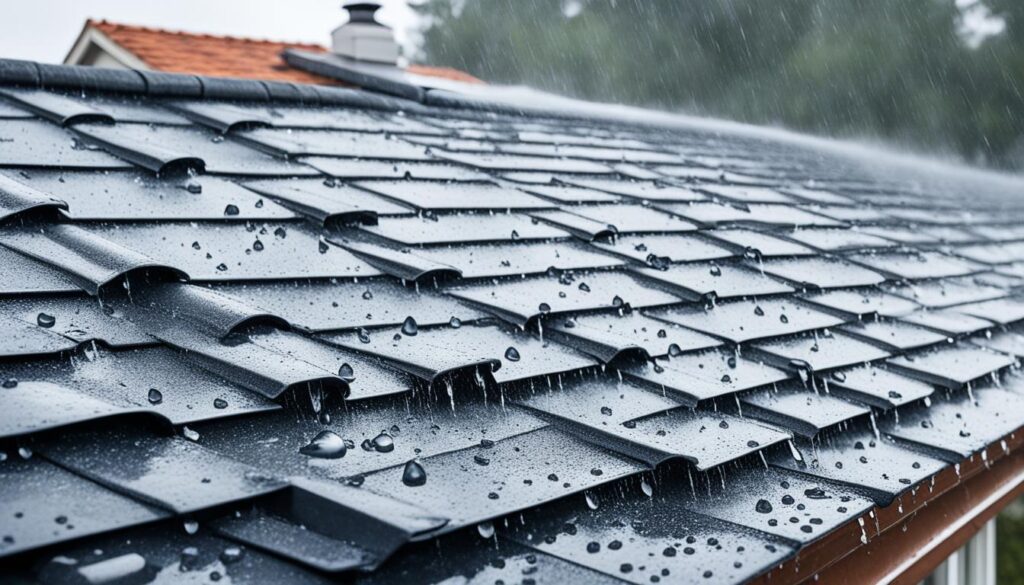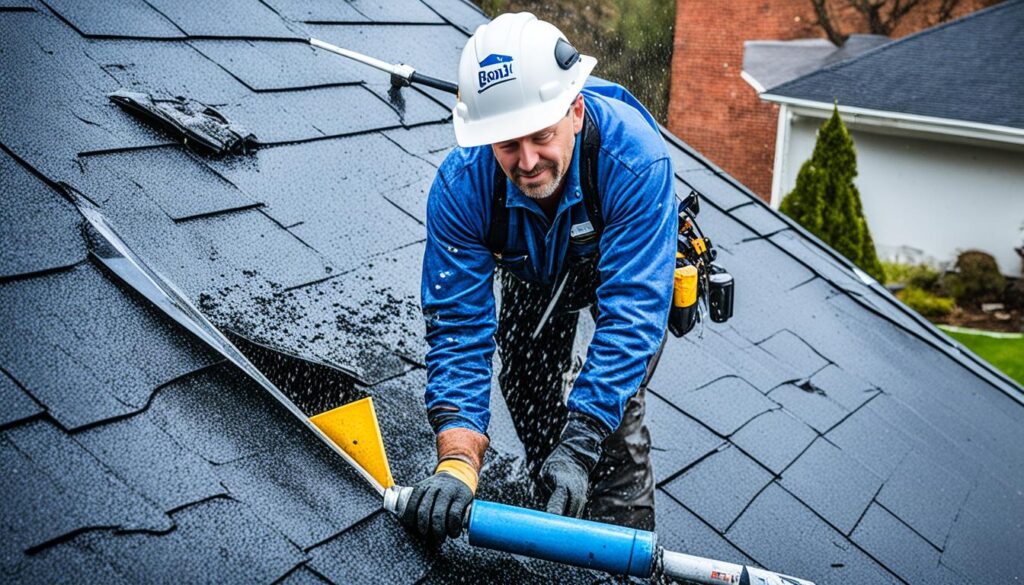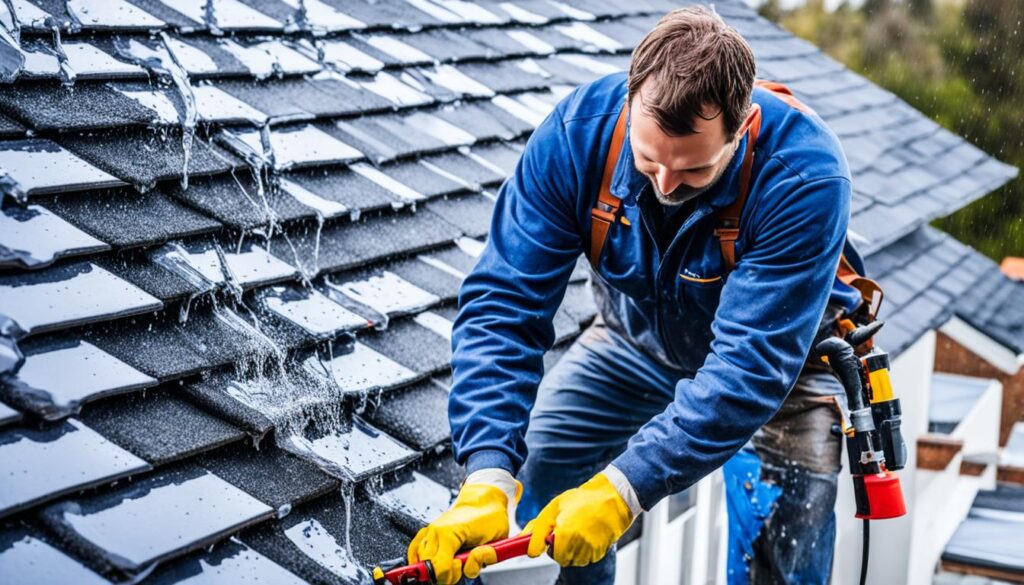Are you tired of dealing with roof leaks during heavy rainstorms? Have you ever wondered how to effectively fix those leaks and protect your home from water damage? Look no further because this article has the answers you’ve been searching for. Whether you’re a seasoned homeowner or a first-time buyer, knowing how to tackle roof leaks in heavy rain is essential for maintaining the integrity of your home. So, how can you fix roof leaks quickly and prevent further damage? Let’s dive in and explore some quick solutions!
Key Takeaways:
- Roof leaks during heavy rain can cause significant damage to your home.
- Knowing the common causes of roof leaks in heavy rain can help you address the issue effectively.
- Detecting roof leaks in heavy rain is crucial for prompt repairs.
- Preventive measures can help you avoid roof leaks during heavy rain.
- Temporary roof leak repairs can be done during heavy rainstorms.
Common Causes of Roof Leaks in Heavy Rain
While heavy rainfall can cause roof leaks, there are specific common causes that homeowners should be aware of. Some of the most common causes of roof leaks during heavy rain include:
- Poor installation: Improper installation of roofing materials can lead to gaps and vulnerabilities that allow water to seep through.
- Missing or damaged shingles: Cracked, loose, or missing shingles can create openings for water to enter.
- Flashing issues: If the flashing around chimneys, vents, or skylights is damaged or improperly installed, it can cause water to penetrate the roof.
- Clogged gutters and downspouts: When gutters and downspouts are clogged with debris, water can overflow and back up onto the roof.
- Roof age and wear: Over time, roofs can deteriorate due to natural aging and wear, making them more susceptible to leaks in heavy rain.
It’s important to address these common causes of roof leaks to prevent water damage to your home. Regular roof inspections, timely repairs, and proper maintenance can help ensure your roof stays watertight even during heavy rainstorms.
Common Causes of Roof Leaks in Heavy Rain
| Cause | Description |
|---|---|
| Poor installation | Improper installation of roofing materials can lead to gaps and vulnerabilities that allow water to seep through. |
| Missing or damaged shingles | Cracked, loose, or missing shingles can create openings for water to enter. |
| Flashing issues | If the flashing around chimneys, vents, or skylights is damaged or improperly installed, it can cause water to penetrate the roof. |
| Clogged gutters and downspouts | When gutters and downspouts are clogged with debris, water can overflow and back up onto the roof. |
| Roof age and wear | Over time, roofs can deteriorate due to natural aging and wear, making them more susceptible to leaks in heavy rain. |
How to Detect Roof Leaks in Heavy Rain
Detecting roof leaks during heavy rain is crucial for prompt repairs. The sooner you identify a leak, the quicker you can take action to prevent further water damage to your home. Here are some signs to look out for that indicate roof leaks in heavy rain:
- Water stains on ceilings or walls: Inspect your ceilings and walls for any discoloration or water stains. These can often indicate a roof leak.
- Dripping or pooling water: If you notice water dripping from the ceiling or pooling on your floors during heavy rain, it’s a clear sign of a roof leak.
- Musty odors: A persistent musty smell in your home, especially during or after rainfall, may be a sign of hidden roof leaks.
- Mold or mildew growth: Excessive moisture from roof leaks can lead to the growth of mold or mildew in your attic, walls, or other areas of your home.
- Wet insulation: Touch your attic insulation during or after heavy rain to check for any wetness. Wet insulation is a strong indication of a roof leak.
- Visible gaps or cracks: Inspect your roof for any visible gaps, cracks, or missing shingles that could be allowing rainwater to enter your home.
By keeping an eye out for these signs, you’ll be able to detect roof leaks in heavy rain and address them promptly.
“Water stains on ceilings or walls can often indicate a roof leak.”
| Signs of Roof Leaks in Heavy Rain | Description |
|---|---|
| Water stains on ceilings or walls | Discoloration or stains on your ceilings or walls can indicate a roof leak. |
| Dripping or pooling water | Water dripping from the ceiling or pooling on the floor during heavy rain is a clear sign of a roof leak. |
| Musty odors | A persistent musty smell, especially during or after rainfall, may indicate hidden roof leaks. |
| Mold or mildew growth | Excessive moisture from roof leaks can lead to the growth of mold or mildew in your home. |
| Wet insulation | Touching wet insulation in your attic is a strong indication of a roof leak. |
| Visible gaps or cracks | Inspect your roof for any visible gaps, cracks, or missing shingles that could be allowing rainwater to enter your home. |
Preventing Roof Leaks in Heavy Rain
When it comes to heavy rain, preventing roof leaks should be a top priority for homeowners. By taking proactive steps, you can protect your roof and ensure your home stays dry and secure. Here are some essential tips to help you prevent roof leaks in heavy rain:
1. Regular Roof Inspections
Regular roof inspections are crucial for detecting any potential vulnerabilities before heavy rain arrives. Hire a professional roofing contractor to assess the condition of your roof and identify any areas that may be prone to leaks. Addressing these issues in advance can save you from costly repairs down the line.
2. Maintain Proper Drainage
Gutters and downspouts play a critical role in guiding water away from your roof and foundation. Clean and inspect them regularly to ensure they are free from debris and in good working condition. Properly functioning drainage systems prevent water from pooling on your roof, reducing the risk of leaks.
3. Trim Overhanging Branches
Overhanging branches can cause damage to your roof during heavy winds and rain. Take the time to trim any branches that are close to or touching your roof. This simple step can prevent branches from scraping against shingles or dislodging them, minimizing the potential for leaks.
4. Check Flashing and Seals
Flashing, which is the material installed around roof penetrations such as chimneys and vents, as well as seals around skylights and other openings, can deteriorate over time. Regularly inspect these areas and ensure they are in good condition. If you notice any cracks, gaps, or signs of wear, repair or replace the flashing and seals to maintain a watertight seal.
5. Address Roof Maintenance Needs
Keep up with routine roof maintenance to prevent leaks during heavy rain. Replace damaged or missing shingles, repair loose flashing, and address any other maintenance needs promptly. Regularly maintaining your roof will help it withstand the harshest weather conditions, including heavy rain.
By following these preventive measures, you can protect your roof from leaks in heavy rain and avoid costly water damage to your home. Remember, if you’re unsure about any maintenance or repairs, it’s always best to consult with a professional roofing contractor.

Roof Leak Repair in Heavy Rain
When faced with a roof leak during heavy rain, it’s crucial to address the issue promptly. While permanent repairs may require professional assistance, there are temporary fixes that homeowners can try to mitigate further damage. Here are some tips for roof leak repair in heavy rain:
1. Locate the Source of the Leak
Before attempting any repairs, it’s important to pinpoint the exact location of the roof leak. Start by inspecting your attic or crawl space for water stains, mold, or dampness. Trace the path of the water to identify the entry point on your roof.
2. Apply Temporary Sealants
Once you’ve located the source of the leak, consider using temporary sealants to stop the water penetration temporarily. Roofing cement or waterproof tape can help seal smaller cracks or gaps in the roofing material.
3. Utilize Tarps or Plastic Sheets
If the leak is significant or cannot be immediately repaired, protect the interior of your home by covering the affected area with tarps or plastic sheets. Securely anchor the coverings to prevent water from seeping through.
4. Clear Debris from Gutters and Downspouts
Clogged gutters and downspouts can exacerbate roof leaks, causing water to overflow onto the roof surface. Regularly remove debris and ensure proper water drainage to minimize the risk of leaks during heavy rain.
5. Seek Professional Assistance
While temporary fixes can provide immediate relief, it’s vital to consult a professional roofing contractor for thorough repairs. They have the expertise and equipment to identify the underlying issues and provide a long-term solution that ensures your roof’s integrity.
| Temporary Roof Leak Repair | Pros | Cons |
|---|---|---|
| Using roofing cement or waterproof tape | – Provides quick and easy application – Offers temporary seal for small cracks or gaps |
– Not a permanent solution – May require regular re-application |
| Covering the affected area with tarps or plastic sheets | – Protects interior from water damage – Relatively inexpensive |
– Does not address the root cause – Does not prevent further roof damage |
Remember, these temporary fixes should only be used as a stopgap measure until professional repairs can be made. It’s essential to address roof leaks in heavy rain promptly to prevent extensive water damage to your home.

Roof Maintenance Tips for Heavy Rain
Proper roof maintenance is essential for preventing roof leaks during heavy rain. By following these roof maintenance tips, you can ensure that your roof remains in good condition and can withstand the challenges of heavy rainfall:
- Regular Inspections: Schedule regular inspections of your roof to check for any signs of damage or wear. Look for cracked or missing shingles, damaged flashing, or clogged gutters.
- Clean Gutters and Downspouts: Clear out any debris, leaves, or twigs from your gutters and downspouts to prevent water from backing up and causing leaks.
- Trim Overhanging Branches: Trim any tree branches that hang over your roof to prevent them from rubbing against the surface during heavy rain and causing damage.
- Check for Proper Ventilation: Ensure that your attic is properly ventilated to prevent moisture buildup, which can lead to mold growth and roof damage.
- Address Moss and Algae: If you notice moss or algae growing on your roof, take steps to remove it. Use a specialized cleaner or hire professionals to safely clean your roof’s surface.
- Reinforce Flashing: Check and reinforce the flashing around chimneys, vents, and skylights to ensure a watertight seal. If you notice any loose or damaged flashing, replace it promptly.
- Remove Snow and Debris: During the winter months, regularly remove snow and ice dams from your roof to prevent water from seeping into your home.
Tip: Remember, it’s always a good idea to consult with a professional roofing contractor for a comprehensive roof inspection and any necessary repairs. They have the expertise to identify potential issues and provide effective solutions for maintaining your roof’s integrity.
Conclusion
Dealing with roof leaks during heavy rain is essential to protect your home from significant damage. By understanding how to fix roof leaks, detect them, and take preventive measures, homeowners can safeguard their homes from water damage. Prompt repairs and regular roof maintenance are crucial in dealing with roof leaks during heavy rain.
If you find that roof leaks persist or are extensive, it’s important to seek professional help from a trusted roofing contractor. They have the expertise and experience to address the issue effectively. Remember, dealing with roof leaks during heavy rain requires immediate attention to prevent further damage.
By following the tips provided in this article, homeowners can effectively handle roof leaks in heavy rain and ensure the integrity of their homes. Remember, prevention is always better than cure, so investing in regular roof maintenance and inspections is key to avoiding roof leaks altogether. Stay proactive and protect your home from roof leaks during heavy rain.

Meet William Adams, a seasoned roofing expert with over 30 years of hands-on experience in the industry. Having worked tirelessly under the scorching sun and through the fiercest storms, William brings a wealth of knowledge and expertise to the table. Hailing from the heart of the USA, he’s witnessed the evolution of roofing practices firsthand, mastering every aspect along the way. Now retired from the field, William spends his days cherishing time with his loved ones while sharing his invaluable insights through this platform. With William at the helm, you can trust that every tip, advice, and recommendation provided is backed by years of real-world experience and unwavering dedication to quality craftsmanship. Join us as we journey through the world of roofing, guided by the wisdom and passion of a true industry veteran.

